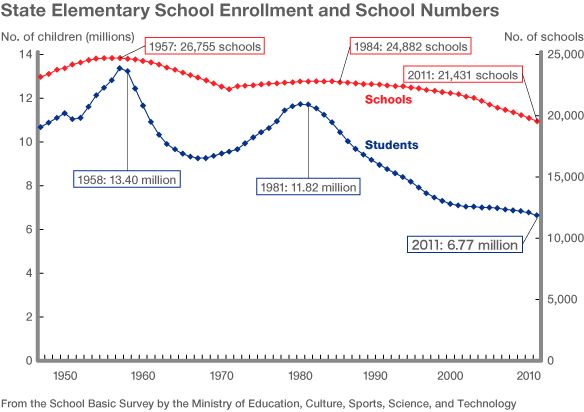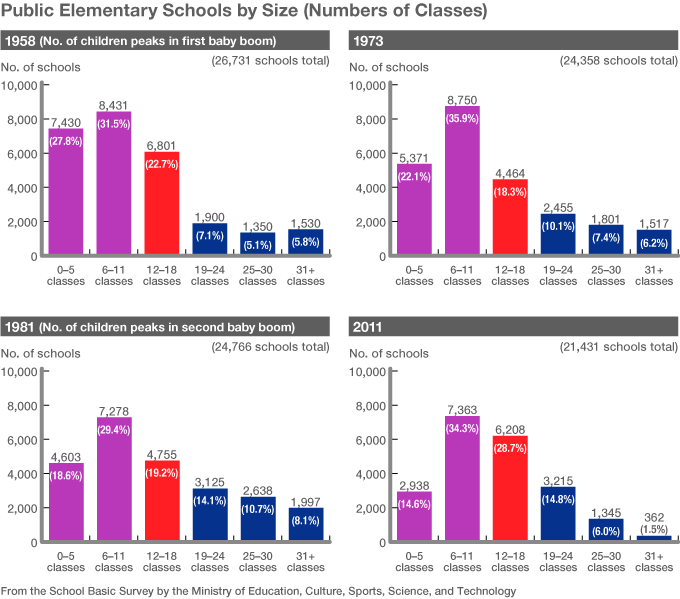
Declining Birthrate Changing Japan’s Schools
Society- English
- 日本語
- 简体字
- 繁體字
- Français
- Español
- العربية
- Русский
Schools in Japan, from elementary to high school level, are being closed at a rate of 400–500 schools per year. The major cause of this is the declining birthrate. Schools overflowing with children are a thing of the past and empty classrooms are increasingly conspicuous. Japan’s declining population is bringing deep change to its schools.
Regional Disparities in Sharp Relief
The number of children in public elementary schools has fallen by about half from a peak of 13.4 million pupils in 1958 to 6.77 million pupils in 2011. The number of schools has decreased from over 26,000 to just over 21,000. Although this is a decrease of less than 20%, the pace is now increasing. Separating the schools by size (using the number of classes) reveals that the number of small schools has decreased and the number of medium-sized schools has increased. We can see from the data that while smaller schools are progressing with mergers and closures, schools larger than a certain size have empty classrooms and are not taking similar steps.

The trend of consolidation, where schools merge or close, manifests in very different ways depending on the region. In less populated areas where schools were already small, the number of children has decreased even further and schools have consolidated. On the other hand, in city suburbs, large-scale schools serving housing complexes constructed during the population boom do not have enough children and do not know what to do with their excess capacity. In city centers, the population is moving to the surrounding suburbs; as children disappear, schools worry about whether they will be able to form a class for each year group. Some prestigious schools are narrowly escaping closures and mergers by admitting children from outside their districts.
The Post-3/11 Role of Japan’s Schools
Japan experienced a sudden decline in student numbers during the 1960s, when the post-war baby boom generation finished school. At the time, the Ministry of Education led the way in demanding cost reductions and school consolidation. However, the hasty consolidation that they demanded resulted in friction between local residents. With this in mind, in the second baby boom, the authorities changed their stance to a less forceful approach to closing and merging schools. The lesson is that excessive rhetoric on public finances can invite a backlash from local residents, causing consolidation efforts to stall.

Given this history, why did the consolidation start again? In addition to the declining birthrate, the wave of municipal mergers that took place from 1996 to 2006 had a strong influence. Municipal governments took the deteriorating condition of public finances as an opportunity to proceed with school consolidation efforts. Progress continued in less populated areas until an event occurred to force a rethinking of the rush to consolidation: the Great East Japan Earthquake last year. In regions that were heavily damaged, schools became evacuation centers and were reevaluated for their role as disaster preparedness sites. Is it acceptable to get rid of schools that are the heart and soul of some regions solely for the sake of public finances? Once more the debate on school consolidations has begun. Given that the birthrate in Japan is forecast to decline even further in the future, we will need to reconsider what to do about “our schools” and the role they have at the core of communities.
(For a more detailed look at the changes facing Japanese education today, see our special report: Japan's Drifting Education System. —Ed.)
Great East Japan Earthquake elementary school school Hayakawa Nobuo birthrate regional disparity Ministry of Education School Basic Survey number of schools number of students